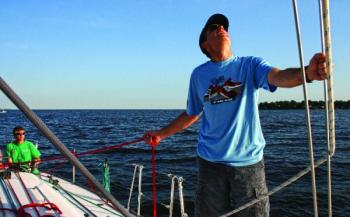 Priorities, priorities…
Priorities, priorities…
The more you race, the more you will realize which things have to happen and which can wait. As you set the spinnaker, for example, is it really important to ease the outhaul, cunningham, and backstay, right now?
The answer is no. All that is critical is to get the spinnaker up, the jib halfway down so the spinnaker fills, and the mainsail and spinnaker trimmed properly. It will be better for boat speed to freeze and to attend to the small details of sail trim later, once the boat has settled down.
Remember this principle after every mark rounding. At the leeward mark, do not detach the spinnaker gear from the spinnaker or do any clean-up other than what is absolutely necessary. Ask the tactician before the rounding if you will need to tack immediately. Hit the rail and tidy up later. Speed first; then go for the good housekeeping seal of approval. There will be appropriate times to flake halyards, pack spinnakers, and move gear.
Have a plan.
Part of identifying priorities is having a game plan. There are four basic evolutions in sailboat racing: tacks, sets, gybes, and douses. Create a plan for your boat. Define the responsibilities of each position for every evolution. You can work out the details in practice. There is no perfect scheme. Just as great golfers are able to achieve the same results with different swing mechanics, you can get the mechanics of boat handling accomplished with a variety of different plans. Whatever works on your boat, with your crew, is right. No matter what scheme you come up with, have the plan outlined so that every member of the crew understands his or her responsibilities. When new crew come on board for a race, you can easily plug them in and define their tasks. (If you need a sample plan, contact me at [email protected]).
Take the initiative.
If you want to graduate from automatron to rock star status, you have to learn to take initiative. For example, if you are the bowman, when you get to the boat, you know that all the gear needs to be led and the sails checked and packed. Do it without being told. When you get out to the race course, make sure your skipper fills you in on the details. Know what the course is and when you start. Have your skipper sail the course in miniature so you can get a sense of the wind angles and velocity for each leg. This will enable you to anticipate the need for spinnaker gear position. Set up all spinnaker gear before the start.
Do not rely on the industry of others.
Think for yourself. As the weather mark approaches, bowmen know how much time they need to get the spinnaker hooked up. Pick the right moment, dive down below, and get it. Stay in the game. React to puffs and lulls and changes in boat speed with the proper weight shift. Keep an eye out for the next mark. The tactician will always appreciate this information. Let the crew in the back of the boat know about major changes up the course: breeze velocity or other boats that are all of a sudden doing something differently. Make sure your information is precise, and be sure not to get everybody talking at once. Too much information is just as bad as too little. You don’t need a continuous play by play. Funnel all information through one person, the tactician.
Good crew is not found; good crew is made.
As crew, you should make sure you sail with someone who appreciates desire and is willing to train. Good skippers have a knack for getting the most out of every person on the boat, and for making everyone feel as if they are part of the game. They ask opinions about trim, speed, and tactical situations (even if they end up ignoring them). They are careful to make sure the whole crew knows how the course is set up and what the tactical plan is. It is this spirit and attitude that create a sense of responsibility and encourage crew members to take the initiative.




